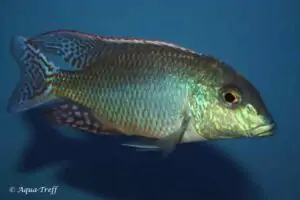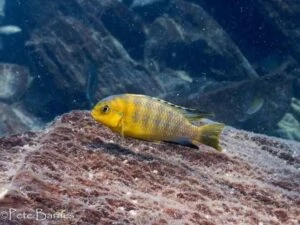Darienheros calobrense
Darienheros, is named after the Darién area between Panama and Colombia, in combination with the ancient cichlid genus name Heros (meaning hero). The name Darién comes from the language spoken by the indigenous Cueva, an Indian tribe that lived in the Darién region of eastern Panama. This name means, the hero of the Darién.
The name calobrensis refers to the Rio Calobre, the river where this species was found first. This river is difficult to locate. On the one hand, many names were changed after Meek’s fishing trips in 1911 and 1912, but on the other hand, the river flows through such a dense forest that it is probably not even visible from above. Meek already mentioned this. The Rio Calobre is a tributary of the current Rio Chepo. It is also striking that in Europe the name Calobrense is used, while in America the name Calobrensis is used.
Synonyms:
Cichlasoma calobrense, Meek et al, 1913
Cichlaurus calobrensis, Jordan et al, 1930
Cichlasoma (Amphilophus) calobrense, Bussing et al, 1975
Amphilophus calobrensis, Kullander, 1996
Darienheros calobrensis, Říčan et al, 2016
Darienheros calobrense
No Astatheros has become a really popular aquarium fish, nor has Darienheros calobrense. This is partly because they are hardly offered, but the fact that they cannot compete with their African cousins in terms of color undoubtedly also plays a role. But still, those who are patient and house them correctly will be rewarded in the long run. In Germany, they don’t call Darienheros calobrensis “Rotpunktbuntbarsch” for nothing. To achieve this, they must first become adults. Colors only become meaningful if you can do something with them. To impress the opposite sex, for example, they will certainly do that if circumstances permit (see aquarium). Long rows of red dots then decorate the body. This pattern also continues in the fins. This combined with the yellow head makes these fish an attractive appearance. On average, the fish grow to about 25 centimeters in size. Males grow slightly larger, are more colorful, and show the onset of a forehead bump later in life.
Origin
Panama
Distribution
They occur in many rivers of Panama such as Rio Bayano, Rio Tuyra, Rio Maye, Rio Sucubti, Rio Cricamola, Rio San Juan, Rio Zepeque, Rio Guarumo. Both in rivers that flow into the Pacific and in rivers that flow into the Atlantic.
Behavior
Somewhat shy fish that defends territories within its own species, but prefers to avoid conflicts with other larger species (medium aggressive). The species does best in group housing combined with a school of additional fish.
Diet
Perhaps slightly less pronounced than with the Cribroheros altifrons to which Darienheros calobrensis is said to be related (Bussing 1973), but it is still good to see that we are dealing with a bottom-oriented sand sifter. The pointed mouth with thickened lips (not clearly visible in the photo) enables this fish to dig through the substrate in search of all kinds of invertebrates. Small crustaceans, worms, larvae of terrestrial insects, and perhaps also small snails form the main menu of Darienheros calobrensis. It cannot be ruled out that they also ingest vegetable food in the form of algae and plant remains. Due to this foraging habit, it is important when caring for them that we offer them sinking food.
Breeding Darienheros calobrense
Darienheros calobrense is an open substrate breeder. When young the sexes are somewhat difficult to distinguish, the differences become more explicit later in life. Nests of up to about 500 fry are cared for by both parents, but slightly more intensively by the female.
The Aquarium
Darienheros calobrensis is one of the more difficult Central Americans to keep. A common problem with these fish is so-called “tearing”. The causes of this condition were shrouded in mystery for a long time, but in recent years, through the linking of enthusiast experiences, they seem to point more and more in a certain direction. They appear to have poor resistance to the bacterial culture in our aquariums. The natural resistance to these bacteria can be reduced by a series of factors. This could include stress, damage to the mucous membrane, or a virus. The care of Darienheros calobrense therefore largely revolves around water hygiene.
We achieve this as follows:
1. Low fish stock (few fish per litre).
2. Avoiding organic decorative materials such as wood.
3. Overcapacity filtering.
4. Regular and ample water changes.
A UV lamp could also provide a solution were it not for the risk that we would neglect the care requirements. If, despite the precautions mentioned, you have not been able to prevent the condition, treatment with metrodinazole is possible.
In view of all the foregoing, it is advisable to provide ample accommodation for the animals. This means that an aquarium under two meters is not suitable for this species. Temperature 26 – 28 degrees Celsius, pH not above neutral. Given the origin (Panama), the water may be a bit softer than for the average Central American.
Author
Rene Beerlink – NVC
Copyright images
F. Ingemann Hansen – Akvariefotografen.com
Reference
- 1913. Described by Seth Eugene Meek and Samuel Frederick Hildebrand in “New species of fishes from Panama” as Cichlasoma calobrense.
- 1996. By Kullander S. in “Heroina isonycterina, a new species of cichlid fish from Western Amazonia, with comments on cichlasomine systematics” as Amphilohus calobrensis.
- 1997. By Roe J.J. et al in Molecular systematics of Middle American cichlids and the evolution of trophic-types in Cichlasoma (Amphilophus) and C. (Thorichthys) ” as Astatheros calobrensis
- 2008. Rican O. et al in “Phylogenetic relationships of Middle American cichlids etc” propose to place calobrense in a new genus to be described. Until this actually happens, we will leave the fish at Astatheros for a while. Because it shows the most similarities (at least morphologically) with this genus.
Literature
Dr. Rüdiger Riehl en Hans A Baensch (1990) Aquarien Atlas band 3, blz 722-723.











Reviews
There are no reviews yet.